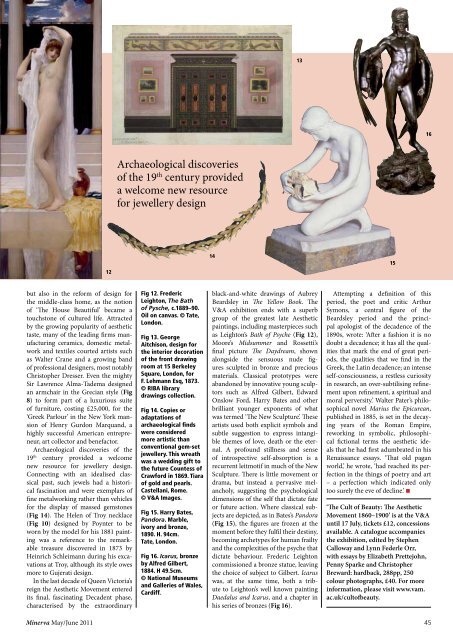Cult of beauty - Minerva
Cult of beauty - Minerva
Cult of beauty - Minerva
Create successful ePaper yourself
Turn your PDF publications into a flip-book with our unique Google optimized e-Paper software.
12<br />
but also in the reform <strong>of</strong> design for<br />
the middle-class home, as the notion<br />
<strong>of</strong> ‘The House Beautiful’ became a<br />
touchstone <strong>of</strong> cultured life. Attracted<br />
by the growing popularity <strong>of</strong> aesthetic<br />
taste, many <strong>of</strong> the leading firms manufacturing<br />
ceramics, domestic metalwork<br />
and textiles courted artists such<br />
as Walter Crane and a growing band<br />
<strong>of</strong> pr<strong>of</strong>essional designers, most notably<br />
Christopher Dresser. Even the mighty<br />
Sir Lawrence Alma-Tadema designed<br />
an armchair in the Grecian style (Fig<br />
8) to form part <strong>of</strong> a luxurious suite<br />
<strong>of</strong> furniture, costing £25,000, for the<br />
‘Greek Parlour’ in the New York mansion<br />
<strong>of</strong> Henry Gurdon Marquand, a<br />
highly successful American entrepreneur,<br />
art collector and benefactor.<br />
Archaeological discoveries <strong>of</strong> the<br />
19 th century provided a welcome<br />
new resource for jewellery design.<br />
Connecting with an idealised classical<br />
past, such jewels had a historical<br />
fascination and were exemplars <strong>of</strong><br />
fine metalworking rather than vehicles<br />
for the display <strong>of</strong> massed gemstones<br />
(Fig 14). The Helen <strong>of</strong> Troy necklace<br />
(Fig 10) designed by Poynter to be<br />
worn by the model for his 1881 painting<br />
was a reference to the remarkable<br />
treasure discovered in 1873 by<br />
Heinrich Schleimann during his excavations<br />
at Troy, although its style owes<br />
more to Gujerati design.<br />
In the last decade <strong>of</strong> Queen Victoria’s<br />
reign the Aesthetic Movement entered<br />
its final, fascinating Decadent phase,<br />
characterised by the extraordinary<br />
Archaeological discoveries<br />
<strong>of</strong> the 19 th century provided<br />
a welcome new resource<br />
for jewellery design<br />
Fig 12. Frederic<br />
Leighton, The Bath<br />
<strong>of</strong> Pysche, c.1889–90.<br />
Oil on canvas. © Tate,<br />
London.<br />
Fig 13. George<br />
Aitchison, design for<br />
the interior decoration<br />
<strong>of</strong> the front drawing<br />
room at 15 Berkeley<br />
Square, London, for<br />
F. Lehmann Esq, 1873.<br />
© RIBA library<br />
drawings collection.<br />
Fig 14. Copies or<br />
adaptations <strong>of</strong><br />
archaeological finds<br />
were considered<br />
more artistic than<br />
conventional gem-set<br />
jewellery. This wreath<br />
was a wedding gift to<br />
the future Countess <strong>of</strong><br />
Crawford in 1869. Tiara<br />
<strong>of</strong> gold and pearls.<br />
Castellani, Rome.<br />
© V&A Images.<br />
Fig 15. Harry Bates,<br />
Pandora. Marble,<br />
ivory and bronze,<br />
1890. H. 94cm.<br />
Tate, London.<br />
Fig 16. Icarus, bronze<br />
by Alfred Gilbert,<br />
1884. H 49.5cm.<br />
© National Museums<br />
and Galleries <strong>of</strong> Wales,<br />
Cardiff.<br />
14<br />
black-and-white drawings <strong>of</strong> Aubrey<br />
Beardsley in The Yellow Book. The<br />
V&A exhibition ends with a superb<br />
group <strong>of</strong> the greatest late Aesthetic<br />
paintings, including masterpieces such<br />
as Leighton’s Bath <strong>of</strong> Psyche (Fig 12),<br />
Moore’s Midsummer and Rossetti’s<br />
final picture The Daydream, shown<br />
alongside the sensuous nude figures<br />
sculpted in bronze and precious<br />
materials. Classical prototypes were<br />
abandoned by innovative young sculptors<br />
such as Alfred Gilbert, Edward<br />
Onslow Ford, Harry Bates and other<br />
brilliant younger exponents <strong>of</strong> what<br />
was termed ‘The New Sculpture’. These<br />
artists used both explicit symbols and<br />
subtle suggestion to express intangible<br />
themes <strong>of</strong> love, death or the eternal.<br />
A pr<strong>of</strong>ound stillness and sense<br />
<strong>of</strong> introspective self-absorption is a<br />
recurrent leitmotif in much <strong>of</strong> the New<br />
Sculpture. There is little movement or<br />
drama, but instead a pervasive melancholy,<br />
suggesting the psychological<br />
dimensions <strong>of</strong> the self that dictate fate<br />
or future action. Where classical subjects<br />
are depicted, as in Bates’s Pandora<br />
(Fig 15), the figures are frozen at the<br />
moment before they fulfil their destiny,<br />
becoming archetypes for human frailty<br />
and the complexities <strong>of</strong> the psyche that<br />
dictate behaviour. Frederic Leighton<br />
commissioned a bronze statue, leaving<br />
the choice <strong>of</strong> subject to Gilbert. Icarus<br />
was, at the same time, both a tribute<br />
to Leighton’s well known painting<br />
Daedalus and Icarus, and a chapter in<br />
his series <strong>of</strong> bronzes (Fig 16).<br />
Attempting a definition <strong>of</strong> this<br />
period, the poet and critic Arthur<br />
Symons, a central figure <strong>of</strong> the<br />
Beardsley period and the principal<br />
apologist <strong>of</strong> the decadence <strong>of</strong> the<br />
1890s, wrote: ‘After a fashion it is no<br />
doubt a decadence; it has all the qualities<br />
that mark the end <strong>of</strong> great periods,<br />
the qualities that we find in the<br />
Greek, the Latin decadence; an intense<br />
self-consciousness, a restless curiosity<br />
in research, an over-subtilising refinement<br />
upon refinement, a spiritual and<br />
moral perversity.’ Walter Pater’s philosophical<br />
novel Marius the Epicurean,<br />
published in 1885, is set in the decaying<br />
years <strong>of</strong> the Roman Empire,<br />
reworking in symbolic, philosophical<br />
fictional terms the aesthetic ideals<br />
that he had first adumbrated in his<br />
Renaissance essays. ‘That old pagan<br />
world,’ he wrote, ‘had reached its perfection<br />
in the things <strong>of</strong> poetry and art<br />
– a perfection which indicated only<br />
too surely the eve <strong>of</strong> decline.’ n<br />
‘The <strong>Cult</strong> <strong>of</strong> Beauty: The Aesthetic<br />
Movement 1860–1900’ is at the V&A<br />
until 17 July, tickets £12, concessions<br />
available. A catalogue accompanies<br />
the exhibition, edited by Stephen<br />
Calloway and Lynn Federle Orr,<br />
with essays by Elizabeth Prettejohn,<br />
Penny Sparke and Christopher<br />
Breward: hardback, 288pp, 250<br />
colour photographs, £40. For more<br />
information, please visit www.vam.<br />
ac.uk/cult<strong>of</strong><strong>beauty</strong>.<br />
<strong>Minerva</strong> May/June 2011 45<br />
13<br />
15<br />
16

















